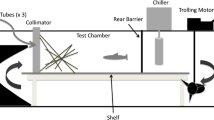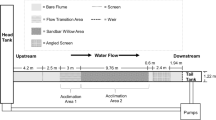Abstract
Fish from lotic environments generally have a variety of flow velocities available to them in their immediate environment. Other than prey availability or predator presence, little is known about what factors determine where in this mosaic of flows an individual fish will choose to locate. Since individuals of a species can have substantially different swimming abilities, and interspecific differences in flow velocity selection have been related to differential swimming abilities, one possibility is that an animal’s physical condition constrains the flow environments it chooses to occupy. Additionally, since the flow in an animal’s environment can contribute to swimming ability, there could also be environmental control over flow selection behavior. This study examined whether flow velocity selection by individual blacknose dace (Rhinichthys atratulus) is a repeatable trait in the laboratory, and whether it is a function of either the animal’s swimming ability or the magnitude of flow in their home stream reach. Blacknose dace from two populations, collected from each of two separate reaches with substantially different flows from within their home streams, exhibited significantly repeatable flow velocity selection over the course of 1 day in the laboratory. The flow velocity selected by the fish varied significantly among individual dace. Some of this variance was accounted for by fish from the slower stream reaches choosing significantly faster flows than did those from faster reaches. There were no significant differences in flow selection behavior between populations. There was also no relationship between sprinting ability and the flow velocity selected by a fish.






Similar content being viewed by others
References
Asaeda T, Kien Vu T, Manatunge J (2005) Effects of flow velocity on feeding behavior and microhabitat selection of the Stone Moroko Pseudorasbora parva: a trade-off between feeding and swimming costs. Trans Am Fish Soc 134:537–547
Dionne M, Dodson JJ (2002) Impact of exposure to a simulated predator (Mergus merganser) on the activity of juvenile Atlantic salmon (Salmo salar) in a natural environment. Can J Zool 80:2006–2013
Fausch KD, White RJ (1981) Competition between brook trout (Salvelinus fontinalis) and brown trout (Salmo trutta) for positions in a Michigan stream. Can J Fish Aquat Sci 38:1220–1227
Heggenes J, Bagliniere JL, Cunjak RA (1999) Spatial niche variability for young Atlantic salmon (Salmo salar) and brown trout (Salmo trutta) in heterogeneous streams. Ecol Freshw Fish 8:1–21
Johnson JH, Johnson EZ (1982) Diet foraging in relation to available prey in an Adirondack Mountain stream fish community. Hydrobiol 96:97–104
Katzman SH, Greathouse J, Roessig JM, Graham J, Cocherell DE, Cech JJ Jr (2010) Water velocity preferences of Coho Salmon during the parr-smolt transformation. Environ Biol Fish 88:79–84
Leavy TR, Bonner TH (2009) Relationships among swimming ability, current velocity association and morphology for freshwater lotic fishes. N Am J Fish Manag 29:72–83
Nelson JA, Gotwalt PS, Webber DW, Reidy S (2002) Beyond Ucrit: Matching swimming performance tests to the physiological ecology of the animal, including a fish “drag strip". Comp Biochem Physiol 133:289–302
Nelson JA, Gotwalt PS, Snodgrass JW (2003) Swimming performance of blacknose dace (Rhinichthys atratulus) mirrors home-stream current velocity. Can J Fish Aquat Sci 60:301–308
Nelson JA, Gotwalt PS, Simonetti CA, Snodgrass JW (2008) Environmental correlates, plasticity, and repeatability of differences in performance among blacknose dace (Rhinichthys atratulus) populations across a gradient of urbanization. Physiol Biochem Zool 81:25–42
Nicoletto PF, Kodric-Brown A (1999) The relationship among swimming performance, courtship behavior, and carotenoid pigmentation of guppies in four rivers of Trinidad. Environ Biol Fish 55:227–235
Oufiero CE, Garland T Jr (2009) Repeatability and correlation of swimming performances and size over varying time-scales in the guppy (Poecilia reticulata). Funct Ecol 23:969–978
Schaefer JF, Lutterschmidt WI, Hill LG (1999) Physiological performance and stream microhabitat use by the centrarchids Lepomis megalotis and Lepomis macrochirus. Environ Biol Fish 54:303–312
Steingrímsson SO, Grant JWA (2011) Determinants of multiple central-place territory use in wild young-of-the-year Atlantic salmon (Salmo salar). Behav Ecol Sociobiol 65:275–286
Tyler JA (1993) Effects of water velocity, group size, and prey availability on the stream-drift capture efficiency of blacknose dace, Rhinichthys atratulus. Can J Fish Aquat Sci 50:1055–1061
Tyler JA, Gilliam JF (1995) Ideal free distributions of stream fish: a model and test with minnows, Rhinichthys atratulus. Ecol 76:580–592
Young PS, Cech JJ Jr (1994) Optimum exercise conditioning velocity for growth, muscular development, and swimming performance in young-of-the-year- striped bass (Morone saxatilis). Can J Fish Aquat Sci 51:1519–1527
Acknowledgements
We thank John M. Eikenberg, Kirk Gastrich, Bridget A. Hill and Sara Weglein for help with making the flow selection chamber “experiment-ready”, Kevin Datoria for field assistance and D.F. Lott for inspiration regarding the experimental design. We gratefully acknowledge the Jess and Mildred Fisher College of Science and Mathematics of Towson University for financial support of NW and support for JJC Jr. by the University of California, Davis, Department of Wildlife, Fish, and Conservation Biology and grant #3455-H of the California Agricultural Experiment Station.
Author information
Authors and Affiliations
Corresponding author
Rights and permissions
About this article
Cite this article
Williamson, N.E., Cech, J.J. & Nelson, J.A. Flow preferences of individual blacknose dace (Rhinichthys atratulus); influence of swimming ability and environmental history. Environ Biol Fish 95, 407–414 (2012). https://doi.org/10.1007/s10641-012-0014-5
Received:
Accepted:
Published:
Issue Date:
DOI: https://doi.org/10.1007/s10641-012-0014-5




